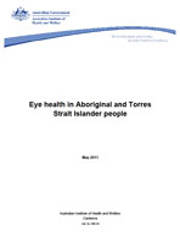Summary
This paper summarises the findings of the 2008 National Indigenous Eye Health Survey (NIEHS). It reports the overall prevalence of blindness and vision impairment in Aboriginal and Torres Strait Islander children aged 5 to 15 years and adults over the age of 40 years. The paper also presents some data from the National Trachoma Surveillance and Reporting Unit, Medicare, hospital data and case studies.
- Over the age of 40 years, Aboriginal and Torres Strait Islander people have 6 times the rate of blindness of other Australians.
- Aboriginal and Torres Strait Islander children have less poor vision than other Australian children.
- 94% of vision loss in Indigenous Australians is preventable or treatable.
- 35% of Indigenous Australian adults report they have never had an eye examination.
Trachoma was found in one-half of the Very remote communities at endemic levels.
- Adults with trachoma scarring and in-turned lashes (trichiasis) are found across the country.
- Australia is the only developed country to still have endemic blinding trachoma.
Refractive error refers to problems with the focusing of light and is a frequent cause of reduced visual acuity.
- Nearly four-fifths (79%) of Aboriginal and Torres Strait Islander adults had self-reported eye problems.
- 83% with self-reported problems had sought care, but of these, 64% reported that their vision problem had not been resolved.
Cataract caused one-third (32%) of blindness in Aboriginal and Torres Strait Islander adults.
- About 65% of people with cataract had been operated on.
Diabetes was reported by more than one-third (37%) of Aboriginal and Torres Strait Islander adults.
- 13% of Indigenous Australians with diabetes had visual impairment.
- But only 20%of those with diabetes had an eye examination in the previous year.
Glaucoma and age-related macular degeneration are still uncommon causes of vision loss in Aboriginal and Torres Strait Islander people.
Existing data sets do not permit the reliable identification of the distribution or the number of eye services provided to Indigenous Australians.
- There appears to be a marked under-resourcing of specialist eye services provided to remote and disadvantaged communities compared with the national average.
- Research suggests that the provision of eye care by Aboriginal Medical Services is associated with better vision outcomes, and that well–coordinated services are more productive, have shorter waiting lists and save money.
Preliminary material: Acknowledgments; Abbreviations
Introduction
- National Indigenous Eye Health Survey
Vision loss
- Causes of vision loss
Provision of eye services to Aboriginal and Torres Strait Islander people
End matter: Further information; References



